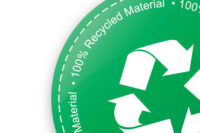Recycled PET usage in domestic markets hits all time high

The National Association for PET Container Resources (NAPCOR) (napcor.com) and The Association of Postconsumer Plastic Recyclers (APR) (plasticsrecycling.org) announced today the release of the “Report on Postconsumer PET Container Recycling Activity in 2014.” The report cites a 2014 United States recycling rate of 31% for polyethylene terephthalate (PET) plastic bottles. The 2014 rate is consistent with that of 2013, reflecting year-over-year increases in both U.S. PET bottle collection volumes and in total volume of PET resin used in U.S. PET bottle production.
Gross exports of PET fell again in 2014, continuing a five-year trend, while total pounds of recycled PET utilized in domestic end-use markets increased to the highest level seen to date.
“We continue to see strong domestic demand for recycled PET in fiber, sheet, bottles, and other end market sectors, with more than 773 million pounds of clean, processed recycled material closing the loop by going back into the production of PET bottles and packaging,” says Tom Busard, NAPCOR chairman, chief procurement officer for Plastipak Packaging, Inc., and President of Clean Tech, Plastipak’s recycling affiliate. “Despite some very real challenges in 2014, including low oil prices and volatile markets, the North American PET reclamation industry continues to process and market more material than ever before. Brand companies, retailers, and product and package designers continue to seek out recycled PET’s preferred environmental footprint.”
Total volume of PET bottles collected increased to 1,812 million pounds in 2014, while the volume of PET bottles in the marketplace and potentially available for recycling increased to 5,849 million pounds. PET bottle bales purchased by export markets in 2014 were at their lowest level since 2004, down another 14% from the significant reductions reported in 2013. Exported material represented 23% of total postconsumer PET volumes collected in 2014, the lowest percentage of domestic material purchased by exporters since that reported in 2000. Total domestic end-use of recycled PET increased from 1,513 million pounds in 2013 to 1,564 million pounds in 2014 – a record high – with significant gains in fiber and sheet end-use market categories. This year’s volumes continue the steady year-over-year increases in use of recycled PET by domestic end markets, and a virtual tripling of the 552 million pounds used just over a decade ago.
“This reports shows a domestic PET recycling infrastructure that is sourcing materials creatively to fill expanding end market needs, through domestic, non-bottle and imported postconsumer PET suppliers,” says Scott Saunders, APR chairman and general manager, KW Plastics Recycling Division. “While the industry still struggles with persistent issues like poor bale quality, it is resilient and robust, and continues to support significant domestic jobs and economic activity.”
Both NAPCOR and the APR continue to work to address the industry’s ongoing challenges, with particular focus on how to maximize the capture of PET from the waste stream, reduce non-PET contamination in recycling streams, and encourage awareness and understanding of “design for recyclability” principles. This is the tenth year that NAPCOR and the APR have partnered to produce this report and the twentieth year that it’s been issued by NAPCOR in its current format. The full “Report on Postconsumer PET Container Recycling Activity in 2014” can be found on the NAPCOR and APR websites.
Looking for a reprint of this article?
From high-res PDFs to custom plaques, order your copy today!






